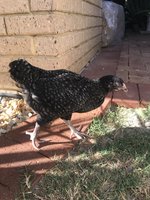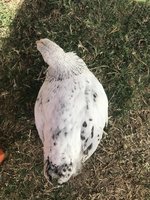Courtney Jane
Chirping
Hi guys! I am a first time chicken owner and I've had my girls for 9 days now. I got them from a friend when they were 6 weeks old and they didn't know what breed they were. They could possibly be a cross breed because it looked like they had a few different ones around the farm. So if anyone could help me out that'd be awesome! They also said they think they were girls but they were too young to know for sure and that i could swap them if they turned out to be boys (which will break my heart!)They've already grown so much and i thought maybe someone could help me out! Theres 3. One white one named Disco, a black one with gold on her chest called Matilda and a black one with white spots all over and her name is Gertrude. I've been doing a lot of reading/watching videos on sexing chickens and i am confused. It seems that Gertrude (spotty) is the smallest with no comb or wattle development as of yet. Disco (white) is the biggest and has very pink comb/wattles. Matilda (black) has comb development but its black and the videos I've been watching are all pink/red comb sexing so I'm a bit confused. I've also noticed that discos posture is different to the other 2. Seems the 2 dark ones stand more upright like roo's but if Gertrude was a roo, why is she also the smallest with no comb development? I thought boys were the biggest and developed combs/wattles first? There's no crowing as of yet but I am aware they can start quite late. Anywho, if anyone's got any answers for me it'd be much appreciated! Also, is it normal for there to be a bit of pinky/red in their droppings every now and then? I've noticed a few around the coop in the last week and i'm a tad worried. There's so much to know about chickens and i'm very paranoid!
Attachments
-
 IMG_3657.JPG502.1 KB · Views: 26
IMG_3657.JPG502.1 KB · Views: 26 -
 IMG_3659.JPG502.4 KB · Views: 29
IMG_3659.JPG502.4 KB · Views: 29 -
 IMG_3660.JPG407.1 KB · Views: 27
IMG_3660.JPG407.1 KB · Views: 27 -
 IMG_3664.JPG751.8 KB · Views: 27
IMG_3664.JPG751.8 KB · Views: 27 -
 IMG_3666.JPG870 KB · Views: 28
IMG_3666.JPG870 KB · Views: 28 -
 IMG_3669.JPG668.2 KB · Views: 111
IMG_3669.JPG668.2 KB · Views: 111 -
 IMG_3677.JPG726.4 KB · Views: 28
IMG_3677.JPG726.4 KB · Views: 28 -
 IMG_3679.JPG746.4 KB · Views: 32
IMG_3679.JPG746.4 KB · Views: 32 -
 IMG_3682.JPG775 KB · Views: 29
IMG_3682.JPG775 KB · Views: 29

